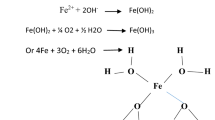Abstract
At room temperature, moisture, SO2, and oxygen permeability of mineral oils, i.e., industrial I‑20A, M-10G2(K) (product and waste, MWO), rapeseed, and sunflower are studied. It is shown that all the studied oils are highly permeable to H2O, SO2, and O2 molecules. For the moisture and SO2 permeability of the studied oils, the following dependences are typical: m(H2O) = ai + biτ and m(SO2) = li + kiτ. The values of ai and li are determined by the nature of the base solvent and the concentration of thickeners (PVK, IFKhAN-29A), which can both suppress and stimulate oxygen permeability.





Similar content being viewed by others
REFERENCES
V. I. Vigdorovich, L. E. Tsygankova, P. N. Bernatskii, and N. V. Shel’, Corrosion and Protection of Metals in Conditions of High Concentrations of Sulfur Oxide(IV) and Its Hydration Products (Izd. Pershina R.V., Tambov, 2015) [in Russian].
V. P. Tomin and Ya. N. Silinskaya, “Influence of products of the reformulation of petroleum feedstock on the course of corrosion processes in technological schemes of oil refining,” Nauchno-Tekh. Vestn. ShchFShch NK Rosneft’, No. 2, 48–53 (2010).
O. P. Filippov, N. S. Yamanina, and A. M. Syrovarova, “Study of the use of waste oils,” Khim. Khim. Tekhnol. 51 (4), 88–91 (2008).
Ya. A. Kamenchuk and S. I. Pisareva, “Changes in the content of oxidation inhibitors and paramagnetic centers in aging of petroleum transformer oils,” Neftekhimiya 46 (5), 395–398 (2006).
V. P. Tomin and Ya. N. Silinskaya, “Study of corrosion processes in technological schemes of deep destructive processes of oil refining,” Korroz.: Mater. Zashch., No. 11, 11–16 (2009).
A. Yu. Osetrov, Extended Abstract of Candidate’s Dissertation in Chemistry (Tambov, 2008).
P. N. Bernatskii, A. A. Dekopolitov, and Yu. V. Panfilov, “Electrochemical behavior of carbon steel in media containing sulfur oxide (IV) and how it is affected by surface films of oil compositions,” Vestn. Tambov. Univ. im. G. R. Derzhavina, Ser.: Estestv. Tekh. Nauki 18 (1), 385–388 (2013).
ACKNOWLEDGMENTS
This work was supported by the Russian Science Foundation, project no. 18-16-00006.
Author information
Authors and Affiliations
Corresponding author
Additional information
Translated by Sh. Galyaltdinov
Rights and permissions
About this article
Cite this article
Vigdorovich, V.I., Shel’, N.V., Knyazeva, L.G. et al. Permeability of Oil Films with Molecules of Water, Sulfur(IV) Oxide, and Oxygen. Polym. Sci. Ser. D 12, 105–109 (2019). https://doi.org/10.1134/S1995421219010246
Received:
Published:
Issue Date:
DOI: https://doi.org/10.1134/S1995421219010246




